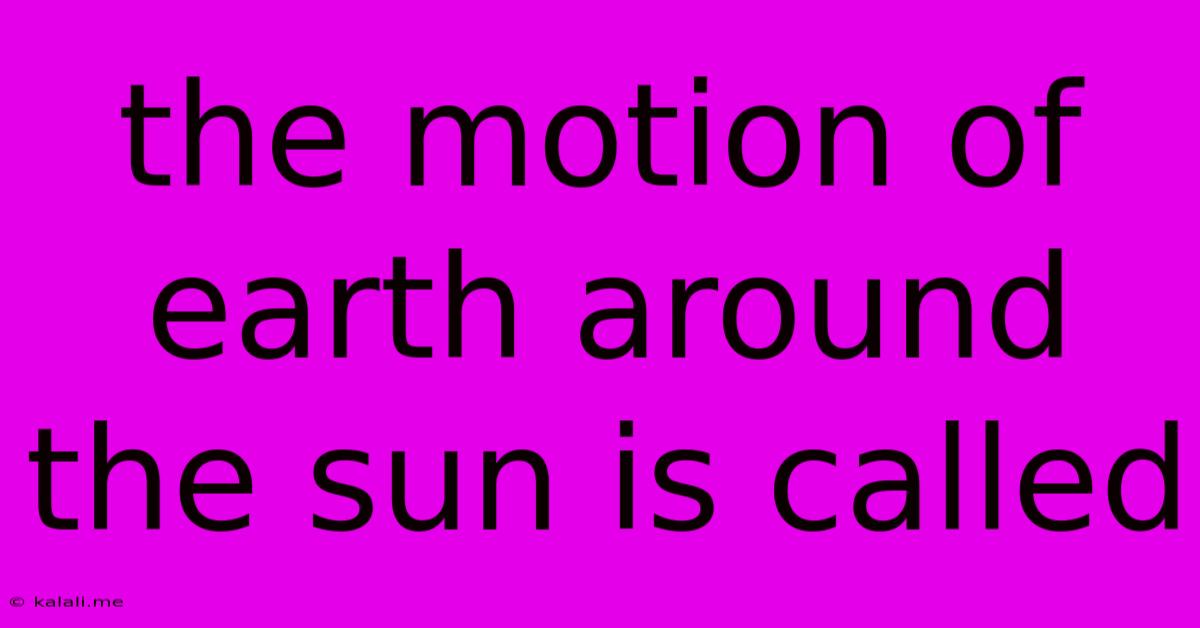The Motion Of Earth Around The Sun Is Called
Kalali
Jun 12, 2025 · 3 min read

Table of Contents
The Motion of Earth Around the Sun is Called Revolution: Understanding Orbital Mechanics
The motion of Earth around the Sun is called revolution. This seemingly simple statement belies a complex interplay of gravitational forces and orbital mechanics that govern our planet's journey through space. Understanding Earth's revolution is crucial to comprehending our place in the solar system and the cycles that shape life on our planet. This article will delve into the details of Earth's revolution, exploring its characteristics, implications, and related concepts like rotation and the seasons.
Understanding Earth's Orbit: An Elliptical Journey
Earth's revolution is not a perfect circle; instead, it follows an elliptical orbit, meaning its distance from the Sun varies throughout the year. This elliptical path is governed primarily by the Sun's gravitational pull. The point in Earth's orbit where it is closest to the Sun is called perihelion, while the point farthest away is called aphelion. These variations in distance subtly influence Earth's climate and seasons, although the tilt of Earth's axis plays a more significant role. The time it takes Earth to complete one revolution around the Sun is approximately 365.25 days, which is why we have leap years to account for the extra quarter-day.
Differentiating Revolution from Rotation: Two Distinct Motions
It's important to distinguish between Earth's revolution and its rotation. Rotation refers to Earth spinning on its axis, which causes day and night. Revolution, on the other hand, refers to Earth's movement around the Sun, which defines a year. While both are fundamental to understanding Earth's celestial mechanics, they are distinct and independent motions. The interaction between these motions influences many aspects of our planet, including the length of days and the experience of seasons.
The Influence of Revolution on Earth's Seasons: Axial Tilt's Crucial Role
While Earth's revolution around the Sun is essential for defining a year, the changing seasons are primarily a result of Earth's axial tilt. Earth's axis is tilted at approximately 23.5 degrees relative to its orbital plane. This tilt means that different parts of Earth receive varying amounts of direct sunlight throughout the year. As Earth revolves around the Sun, the hemisphere tilted towards the Sun experiences summer, while the opposite hemisphere experiences winter. This is why the seasons are opposite in the Northern and Southern Hemispheres. The equinoxes, occurring around March and September, mark the times when both hemispheres receive roughly equal amounts of sunlight.
Orbital Mechanics and Kepler's Laws: Governing Principles
The precise nature of Earth's revolution is described by Kepler's Laws of Planetary Motion. These laws, formulated by Johannes Kepler in the 17th century, mathematically describe the motion of planets around the Sun. They describe the elliptical nature of orbits, the relationship between a planet's orbital speed and its distance from the Sun, and the relationship between the orbital period and the semi-major axis of the ellipse. These laws are fundamental to our understanding of celestial mechanics and are still relevant today in the study of orbital dynamics and space exploration.
Conclusion: Understanding Our Place in the Cosmos
The motion of Earth around the Sun, known as revolution, is a cornerstone of our understanding of our place in the universe. By understanding the interplay of gravitational forces, orbital mechanics, and the significance of Earth's axial tilt, we gain a deeper appreciation for the complex processes that shape our planet and the cycles of life upon it. From the variations in distance at perihelion and aphelion to the seasonal changes driven by axial tilt, Earth's revolution is a fundamental aspect of our existence. Further exploration into these concepts can lead to a richer understanding of astronomy and the broader field of astrophysics.
Latest Posts
Latest Posts
-
Which Test Is Not A Projective Test
Jun 13, 2025
-
Which Of The Following Is An Open Ended Question
Jun 13, 2025
-
Which Of The Following Are Not Units Of Pressure
Jun 13, 2025
-
What Is The Antonym For Hostile
Jun 13, 2025
-
Density Of Water At 4 Deg C
Jun 13, 2025
Related Post
Thank you for visiting our website which covers about The Motion Of Earth Around The Sun Is Called . We hope the information provided has been useful to you. Feel free to contact us if you have any questions or need further assistance. See you next time and don't miss to bookmark.